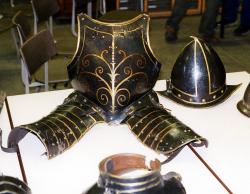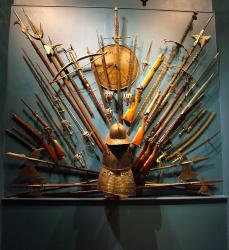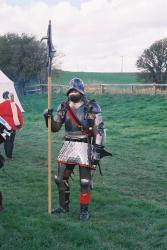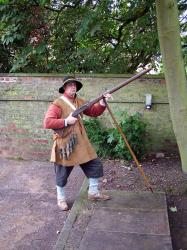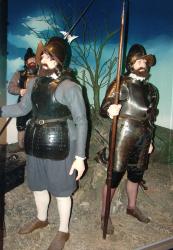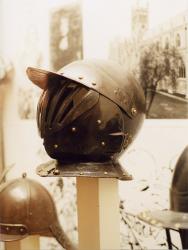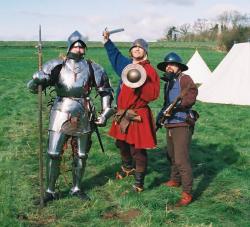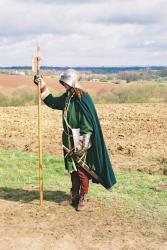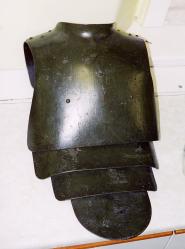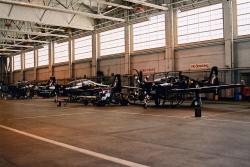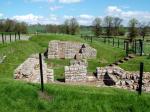Translate this Page
Recent images :
- International Harvester M5 halftrack
- Dassault Mystère Mk IVa number 146
- Ark Royal, Anti-ship missile defence gun.
- RAF Series 2 Land Rover
- Lightweight, air portable Land Rover
- Daimler Ferret Mk 1/2 Armoured Car
- RAF Mountain Rescue Series 3 Land Rover
- French Bronze 6 pounder cannon
- Farsley South African War Memorial
- Farsley War memorial
Images of Personal Armour
Click on the entry for a larger image and details, or click to go back to the previous index
Flambouyant armour from Italy during the 1500's. The painting is not original.
Taken at the York Castle Museum, York, England, 2003
A elegant display of arrayed weaponry from medieval polearms and 2-handed swords through to 19th century percussion muskets and carbines. There are rapiers, basket-hilt broadswords, bayonets, halberds and a crossbow arranged around a 17th century (En...
Taken at the York Castle Museum, York, England, 2005
This man-at-arms wears quite an exotic suit of full armour of 15th century style and is armed with a bill polearm. Member of the Black Guard re-enactment group.
Palm Sunday Battlefield event, Towton, North Yorkshire, 2004
A member of the Tower Hamlets Trayned Band showing how a Civil War musketeer would have been armed. He has a matchlock musket of the period, with a rest, and the match (a piece of slow-burning fuse used to light the priming powder which in turn ignit...
Mill Mount, York, England. September 2004
Two examples of the types of armour and weapons as used by the Reivers - cross Anglo-Scottish border warriors - during the 16th century.
The model on the left wears a simple back and breast armour with lower abdomen protection more common in pikemen...
Taken at the York Castle Museum, York, England, 2005
This English breastplate and backplate from the mid 17th century illustrates the basic protection considered necessary for a soldier of horse of this period. The breastplate is musket-proof (see the small dent or proof mark just the the right of cent...
Taken at the York Castle Museum, York, England, 2003
A pair of full-face close helmets worn by cuirassiers during the English Civil War. The helmets would be part of an all-over plate armour similar to the later medieval knights except that the leg armour tended to be fully articulated and ended at the...
Taken at the York Castle Museum, York, England, 2003
Here are depicted three different types of foot soldier from the time of the battle of Towton, 1461. On the left, he is a fully armoured man-at-arms with battle axe. In the centre is a foot soldier in the livery of the House of York armed with sword ...
Palm Sunday Battlefield event, Towton, North Yorkshire, 2004
A Pikeman's back and breastplate from around 1660 of the pattern used during the English Civil War. It also shows the hinged plates which would have covered the wearer's lower abdomen and upper leg area. Also the the left can be seen a Lobster helm a...
Taken at the York Castle Museum, York, England, 2003
This three-barred pott helmet was worn by an harquebusier, a more modern type of cavalryman armoured just with a buff coat, back and breastplate and this type of helmet. It became known as a 'lobster pott' due to the plated rear neck protector and th...
Taken at the York Castle Museum, York, England, 2003
This foot soldier of the Wars of the Roses period is dressed in a long cloak and jerkin civering a mail shirt, and has a salet for head protection and armour gauntlets. He has a bill polearm and a sword. Member of the Company of Palm Sunday group.
Palm Sunday Battlefield event, Towton, North Yorkshire, 2004
A rare example of body armour used by the German Army during World War 1. It was incredibly heavy and simply hung from the shoulders and protected the chest and abdomen (the lower portion is articulated by means of canvas straps to allow a little fle...
Taken at the York Castle Museum, York, England, 2003

